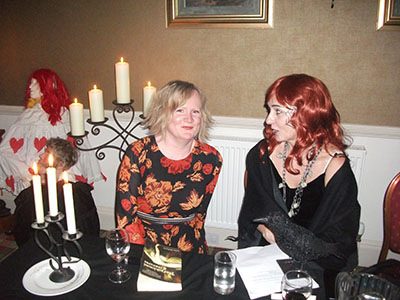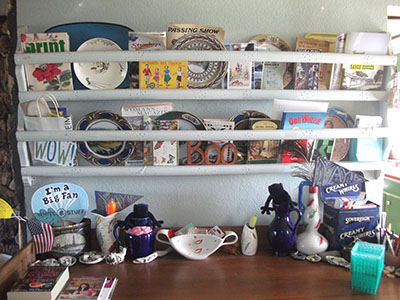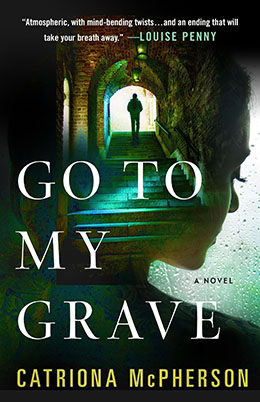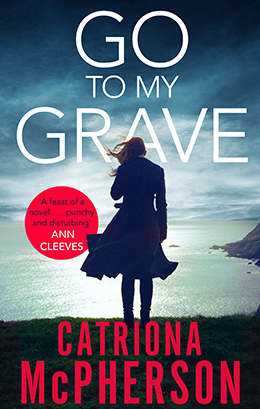From The Booking Desk:
Catriona McPherson is not only one of my favorite storytellers, but she is also one of my favorite people. Period! Her new novel, Go To My Grave, warms my Gothic-loving heart, so I asked Catriona here to talk about all things Gothic. Of course, Catriona’s wit and humor shine through even when she is discussing the dark and brooding. And as always, she manages to educate us a bit along the way. Look for the BOLO Books review of Go To My Grave soon – after having read the book, I am now listening to the wonderful audiobook version as well. Yes, the book is that good.
Putting the Gahhhhh! In Gothic
by Catriona McPherson
 I don’t look Gothic: my hair colour is a Doris Day tribute shade; I’ve got dresses with buses, trains, wee birds and garden gnomes on; and the hardest type of plastic to give up was glitter.
I don’t look Gothic: my hair colour is a Doris Day tribute shade; I’ve got dresses with buses, trains, wee birds and garden gnomes on; and the hardest type of plastic to give up was glitter.
But I write Gothic. Apparently. (Library Journal and Ann Cleeves both called Go To My Grave Gothic and Lori Rader-Day said it was “messed-up”, which also made me very happy.) Or do I? “Gothic” is an official literary category like “Romantic” and “Tragic” even though we use all three willy-nilly outside the English classroom.
In fact, I was once on a serious panel called “The Gothick in Fiction” – that K shows they meant it – where literary critic Lesley McDowell tried to have a sincere discussion and crime novelist Caro Ramsay turned up with a plastic crow. I’ve got a photographic record of the exact moment Lesley gave up.
 It’s easy enough to list examples of Gothic work. Starting, everyone agrees, with Horace Walpole’s The Castle of Otranto in 1764, and lurching like a creepy butler through Frankenstein and Dracula, picking up Wuthering Heights and Rebecca, curtseying to some bits of Dickens and Poe, before arriving at The Rocky Horror Show, which must be the summit (surely), we know Gothic when we see it. We can check things off a list: there’s a damsel in distress, a big house, and an irresistible – although much to be resisted if you know what’s good for you – villain. But you get a damsel, a villain and a big house in Pride and Prejudice too. So there must be more to Gothic than character, plot and setting. Of course there is. Gothic is about tone, perspective, sensibility.
It’s easy enough to list examples of Gothic work. Starting, everyone agrees, with Horace Walpole’s The Castle of Otranto in 1764, and lurching like a creepy butler through Frankenstein and Dracula, picking up Wuthering Heights and Rebecca, curtseying to some bits of Dickens and Poe, before arriving at The Rocky Horror Show, which must be the summit (surely), we know Gothic when we see it. We can check things off a list: there’s a damsel in distress, a big house, and an irresistible – although much to be resisted if you know what’s good for you – villain. But you get a damsel, a villain and a big house in Pride and Prejudice too. So there must be more to Gothic than character, plot and setting. Of course there is. Gothic is about tone, perspective, sensibility.
Walpole said what he was doing was mixing the mystical and supernatural elements of mediaeval romance (whose plots he found silly) with the narrative discipline of this new trend called “novels” (whose realism he found constraining). Modern online definitions say things like “the thrill of terror” and “extremes of Romanticism”. I’d sum it up as A. Death is sexy and B. More is More.
Let’s take B first. Gothic is never minimalist, whether it’s architecture, fiction or fashion. And neither am I. See this?

That’s the plate rack that greets visitors just inside my front door. It’s about half-full to my way of thinking. Also, my favourite writers are the expansive ones. I prefer Joyce Carol Oates to Joan Didion and Stephen King to Truman Capote. When it comes to my own writing I like to give it fifteen twists then spit on my hands and twist once more. “What? NO! Stop.” is my idea of a great edit note to get on a penultimate chapter.
 What of A. though. Is death sexy? Or, in a less extreme version, is pain pleasure? Are Heathcliff, Maxim de Winter, Count D. and The Creature boyfriend material? Um, no. Not in my book. And neither’s Mr Darcy. Pillock. Although even he’s better than Mr Knightley. Tedious pillock. My first question to any fellow Buffy fan on first meeting is: Spike or Angel? And the correct answer is Spike (funny, open, Doris Day tribute hair), not Angel (brooding, morose, full of secrets).
What of A. though. Is death sexy? Or, in a less extreme version, is pain pleasure? Are Heathcliff, Maxim de Winter, Count D. and The Creature boyfriend material? Um, no. Not in my book. And neither’s Mr Darcy. Pillock. Although even he’s better than Mr Knightley. Tedious pillock. My first question to any fellow Buffy fan on first meeting is: Spike or Angel? And the correct answer is Spike (funny, open, Doris Day tribute hair), not Angel (brooding, morose, full of secrets).
And as for the mysticism? I’ve got absolutely no supernatural beliefs whatsoever. Not a one. I believe in physics, chemistry, biology, honesty, courage and love. That’s it.
 So how come I’ve written books set in . . . just a selection . . . a convent on a moor top, a psychiatric hospital on a lonely headland, and a castle where they’re putting on a production of Macbeth, for crying out loud? I’ve written a book where the damsel doesn’t understand why the flat above the butcher’s shop is rent-free (or what happened to all the earlier tenants), and one where dotty amateur taxidermists have got something behind a locked door in their museum. I take both these promises to my readers seriously, by the way: if you put butchers and/or taxidermists in a novel, you have made a covenant that must be honoured. (I’ve got limits, mind you: whenever I’m signing As She Left It, a book where a toddler went missing ten years before the story opens and there’s an outhouse with concrete poured in the window to waist height, I always say “Don’t worry. I would never.” Even though, in another book, I kind of did.) I’ve also written about gods and ghosts aplenty.
So how come I’ve written books set in . . . just a selection . . . a convent on a moor top, a psychiatric hospital on a lonely headland, and a castle where they’re putting on a production of Macbeth, for crying out loud? I’ve written a book where the damsel doesn’t understand why the flat above the butcher’s shop is rent-free (or what happened to all the earlier tenants), and one where dotty amateur taxidermists have got something behind a locked door in their museum. I take both these promises to my readers seriously, by the way: if you put butchers and/or taxidermists in a novel, you have made a covenant that must be honoured. (I’ve got limits, mind you: whenever I’m signing As She Left It, a book where a toddler went missing ten years before the story opens and there’s an outhouse with concrete poured in the window to waist height, I always say “Don’t worry. I would never.” Even though, in another book, I kind of did.) I’ve also written about gods and ghosts aplenty.
Here comes the answer to the puzzle of how such a Hairspray person writes such Phantom of the Opera novels. (Ha! I’m writing for Kris and his passion for Broadway is catching). The answer is . . . Jane Austen. In Northanger Abbey, she takes a heroine in thrall to all things Gothic (locked boxes, moonlight flits, dastardly villains, horrific secrets and – well – abbeys) dials everything up to eleven and then shows Catherine Morland, and us, that real horror, real cruelty and real danger are human, not monstrous, and all the worse for it.
That’s my corner of this big, mad, writing world. I like to play with the tropes of Gothic fiction – maybe more so in Go To My Grave than in any previous book (I mean “Lock it in a box, stitch my lips and go to my grave” isn’t the sort of deal you find in an everyday NDA) but it’s the evil that men (and women) do that interests me. As my Grandad MacDonald used to say – of walking past a graveyard, but it does just as well for living in one, like Jude in Quiet Neighbors – “It’s the living you need to watch out for, hen. Not the dead.” Buffy fan, King super-fan and noted scaredy-cat around graveyards that I am, I agree.
Buy Links: Go To My Grave by Catriona McPherson
______________________________________________________________________
Catriona McPherson is the multi-award-winning author of the Dandy Gilver mysteries, set in Scotland in the 1930s where (but not when) she was born. She also writes contemporary standalones, which have been Edgar and Mary Higgins Clark finalists. The latest is GO TO MY GRAVE, which Kirkus called “a virtuoso exploration of guilt, remorse, and revenge” in a starred review.
Catriona immigrated in 2010 and lives in northern California with a black cat and a scientist. She writes full-time. www.catrionamcpherson.com.

I wrote a long loving comment but that damn capcha times out, and the whole thing got nuked
Short version: Catriona is frabjous
Ann, I’ve started copying my comments on almost anything, anywhere since I’ve lost so many. It’s so frustrating when it disappears.
Just read my first Catriona McPherson- Go to My Grave. It will not be my last one. The book was fantastic and I was happy to read it, especially as I met Catriona at Malice Domestic in April. She is great
You have some wonderful reading ahead of you!
I love the photo of the plate rack!
I discovered what I consider Gothic when I picked up my first Victoria Holt book in the 8th grade library – Bride of Pendorric. It had a mad woman who looked just like everyone else. Scared me to death – loved it. Then I discovered Barbara Michaels. I’ve been a Gothic lover ever since – whatever you consider Gothic. Looking forward to reading this one so much. And as to Angel or Spike (Spike every single time – ha!).
Huge Holt fan here as well.
So glad you talk about Northanger Abbey, because I love LOVE that! Oh, and Dracula too (though it scared the bejuggers out of me when I read it while staying alone in a creepy Catholic youth hostel in London when I was twenty years old.)
Other than those, I’m not a huge Gothic–or Gothick–fan, but having read the first few pages of Go to My Grave, I am definitely going to read the rest of it!
Fun description of Gothic. I still remember the first one I read, “Mistress of Mellyn” by Victoria Holt. Btw, you did a fabulous job as Toastmaster at Malice this year. I loved your speeches.
As others have commented, Victoria Holt was my gateway into Gothic, Mistress of Mellyn from my mother’s books. Go to My Grave is my kind of Gothic these days, with, as you say, Catriona, the tropes present but not drowning in Gothic. Go to My Grave was such a perfect read for me. It’s definitely on my Favorite Reads list this year and beyond. Loved this article, too, Catriona, and thanks, Kristopher, for bringing it to us. Oh, and the plate rack is awesome. I like to have interesting items out for my grandkids to explore and count on them remembering me as the grandmother with the house of curiosities.
Youe plate rack is divine, Catriona. Couldn’t put GRAVE down and finished It waiting for my hubby to come out of surgery today— how’s that for a dedicated reader?! Gothic galore and then some! Loved it!! Review to follow~